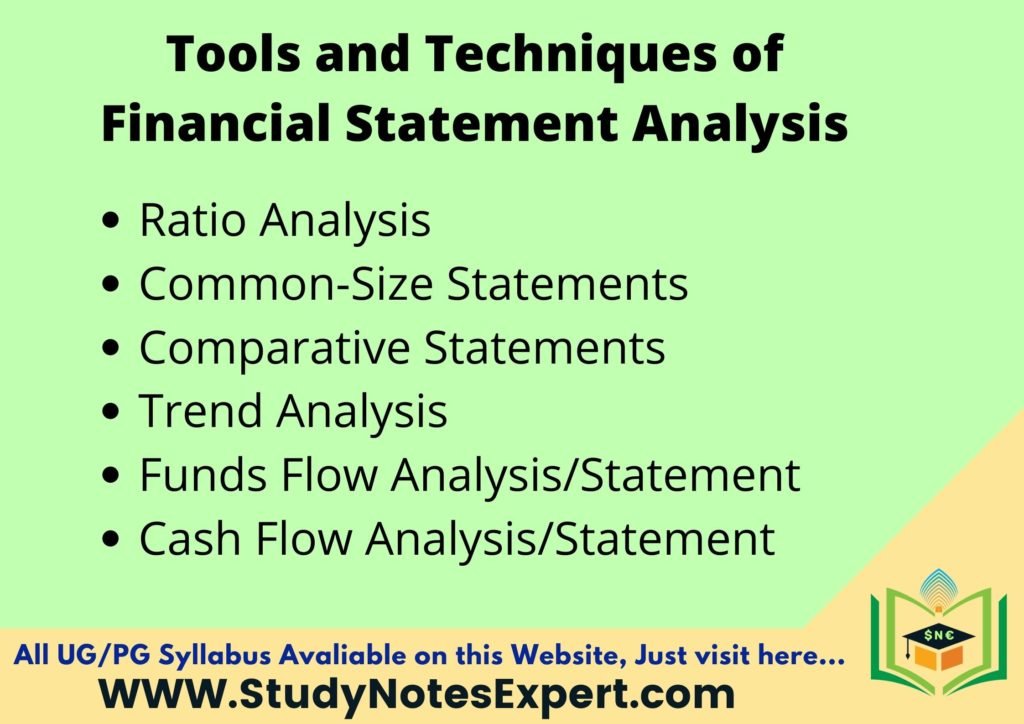This article will discuss all the probable tools and techniques of financial statement analysis. The financial statement analysis is a tool through which various components of profitability during a specific period. Also, in the financial Status, an organization is subjected to detailed scrutiny, analysis, and interpretation on a particular date. It is the collective effort of all aspects. Let’s we discuss the financial analysis tools ahead of the article. The most commonly used tools for financial analysis are ratio analysis, comparative statements, common size statements, etc.

1) Ratio Analysis
Ratio Analysis is a quantitative analysis technique that establishes the relationship between two or a combination of more than two items of financial statements. Both are Balance Sheet, Income Statement, and Cash Flow Statement. It is usually used to evaluate various aspects of a company’s operating and financial performance. That financial performance, like its efficiency, liquidity, profitability, and solvency, is helpful for the management in making certain decisions.
2) Common-Size Statements
A common-size statement play an essential role in the tools and techniques of financial statement Analysis. Its direct impact on the company’s financial statements displays all items as a percentage of a common base figure. It is one of the financial analysis techniques. It is known as the Common-Size Statements. It facilitates comparative analysis between two or more companies or between two or more periods of a company.
3) Comparative Statements
An organization’s financial statements for different periods are called Comparative Financial Statements. To know about the comparative statement users need to use the tools or techniques of financial statement analysis. Various items of financial statements are presented in a comparative form which may be a table. It enables one to have a comparative view of multiple parameters for two or more periods at a glance. Comparative statement is important in the sense of financial tools and techniques.
Also Read: Top 10 Limitations of Financial Statement
4) Trend Analysis
Trend analysis is also an important part of the tools and financial analysis techniques. It is based on the underlying premise that what has happened in the past indicates what will happen in the future. Trend analysis is the techniques of financial analysis. It may be defined as a mathematical technique that uses historical data to forecast future outcomes. Trend Analysis may be undertaken in respect of two organizations for the same period or an organization for a different period. A trend is a series of information from the financial statements analyzed to arrive at meaningful conclusions. To know about the trend of financial trend user need to use the tools of financial statement analysis.
5) Funds Flow Analysis/Statement
If we have no funds flow statement, we cannot use the tools and techniques of financial statement analysis. It is a statement that depicts the sources. Applications of funds for a specific period. Through the fund flow statement, research concerning the changes in the financial position of an organization from the beginning of a period to its end is undertaken. It is the most valuable financial analysis tools that are using in financial statement analysis.
6) Cash Flow Analysis/Statement
A cash flow statement is a financial statement, which shows how Cash and Cash Equivalents in a business are affected by changes. It is one of the techniques of financial analysis. And, it also describes how-to guides in various components of Balance Sheet and Profit and Loss Accounts. Cash Flow statement is the financial analysis techniques. It summarizes the reasons behind the changes in the cash position of a business entity between the dates of the two balance sheets.
Also, if you received your finance sheets as an image and want to sort them into tabular form, then simply visit theonlineconverter to convert it into an Excel spreadsheet using OCR image to Excel converter.
These tools and techniques may be used to answer numerous questions about an company’s financial/economic health, including:
- How has the company’s financial performance changed over time?
- How does the company’s financial performance compare to its industry peers?
- Is the company generating enough cash to meet its obligations?
- Is the company using its debt wisely?
- Is the company managing its assets effectively?
Traders, creditors, and other stakeholders can better understand a company’s financial health and overall performance using these tools and techniques. These facts may be used to make informed decisions approximately whether or not to invest in the organization, lend money, or do business with the organization.
Here are a number of the advantages of using tools and strategies for monetary declaration evaluation:
- It lets you pick out developments in a company’s overall monetary performance.
- It will compare a company’s overall financial performance to its industry peers.
- It permits you to assess a company’s ability to generate and control coins.
- It assists you to perceive capability dangers and issues with an employer’s financial health.
- It will let you make informed selections about whether or no longer to spend money on an organization, lend cash to a company, or do business with a company.
If you are curious about gaining knowledge of more approximately financial assertion analysis, many sources are available online and in libraries. You can also take courses or workshops on monetary assertion analysis.
Conclusion
These are the all major tools and techniques of financial statement analysis. All financial tools and techniques play an important role in the financial statement. These different methods of financial statement analysis are ratio analysis, trend analysis, comparative analysis, etc.
What are the 5 methods of Financial Statement Analysis?
The five methods of financial statement analysis are horizontal analysis, vertical analysis, ratio analysis, trend analysis, and comparative analysis.
What are the Different Types of Financial Statement Analysis?
These are the types of financial analysis tools:
1. Common-size Analysis
2. Ratio Analysis
3. Trend Analysis
4. Comparative Statements
What are the Different Tools for Financial Statement Analysis?
1. Common-size Analysis
2. Ratio Analysis
3. Trend Analysis
4. Comparative Statements
5. Funds Flow Analysis
6. Cash Flow Analysis
List any two Tools of Financial Statement Analysis?
The major two tools of financial analysis are:
1. Common Size Statements
2. Comparative Statements

